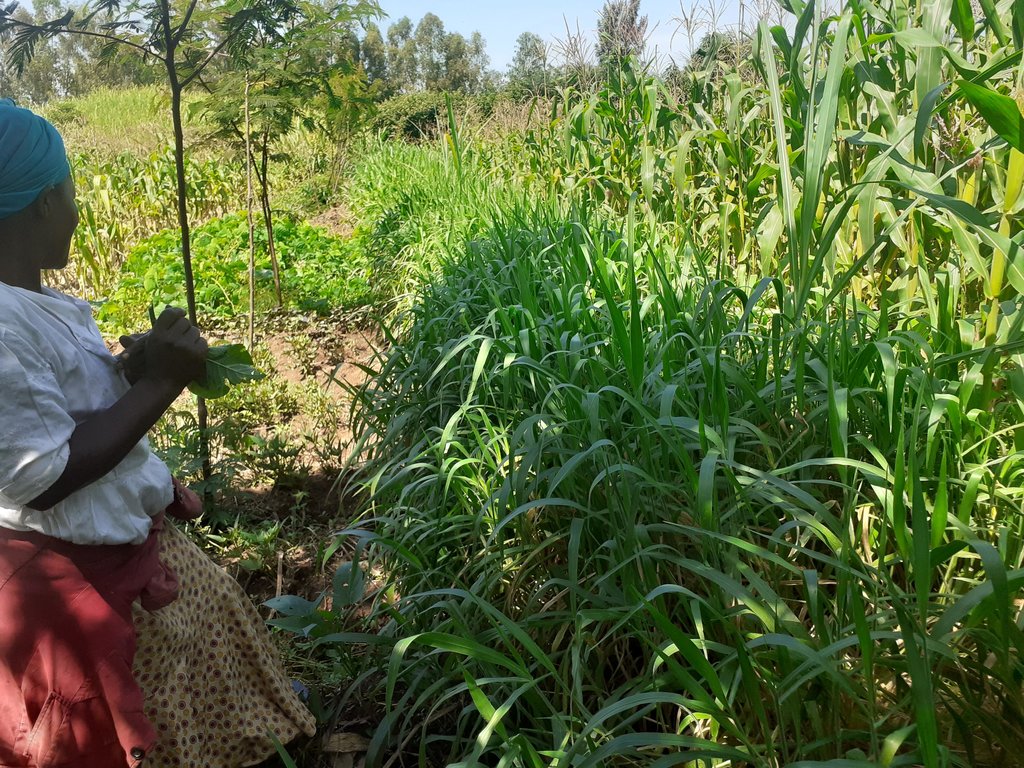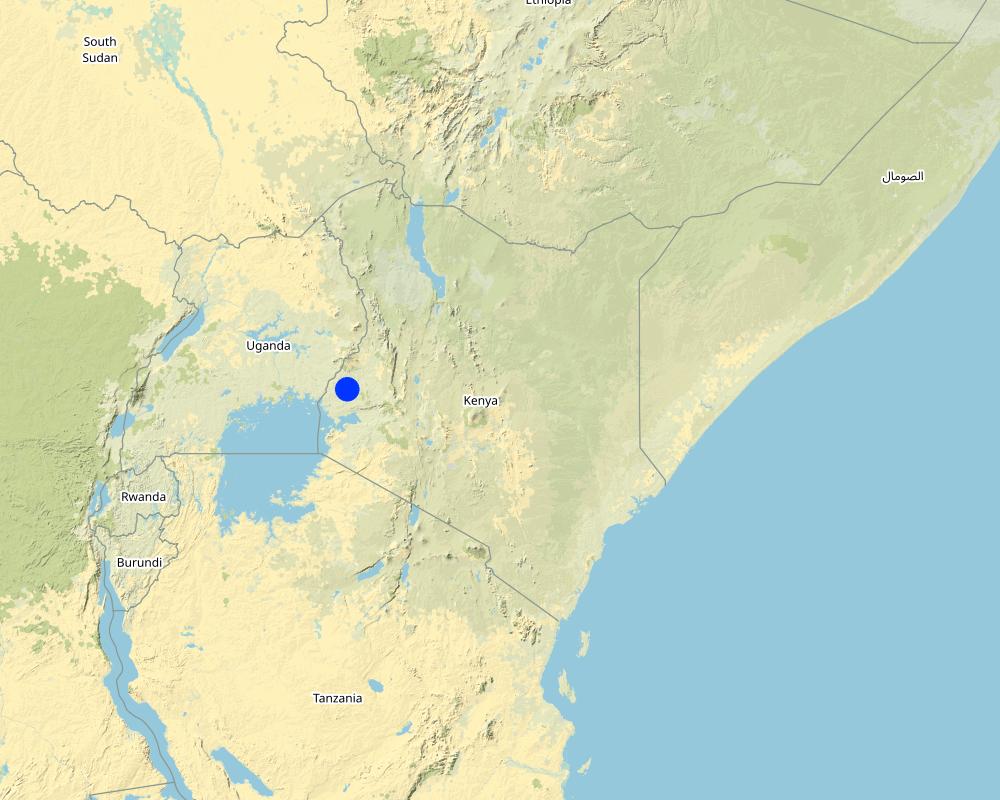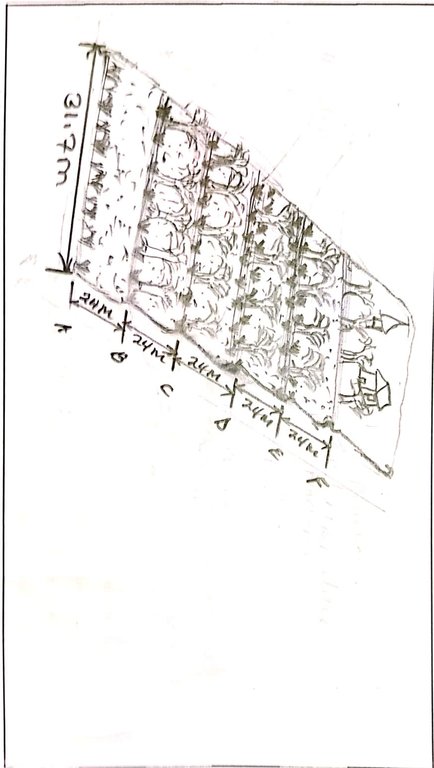Vegetative cross-slope barriers [肯尼亚]
- 创建:
- 更新:
- 编制者: William Akwanyi
- 编辑者: George Onyango, Innocent Faith, Noel Templer
- 审查者: William Critchley, Rima Mekdaschi Studer
technologies_6705 - 肯尼亚
查看章节
全部展开 全部收起1. 一般信息
1.2 参与该技术评估和文件编制的资源人员和机构的联系方式
关键资源人
土地使用者:
Osundwa Amirah Munyolo
Welthungerhilfe farmer
肯尼亚
SLM专业人员:
SLM专业人员:
有助于对技术进行记录/评估的项目名称(如相关)
Soil protection and rehabilitation for food security (ProSo(i)l)有助于对技术进行记录/评估的机构名称(如相关)
Deutsche Gesellschaft für Internationale Zusammenarbeit (GIZ)有助于对技术进行记录/评估的机构名称(如相关)
Alliance Bioversity and International Center for Tropical Agriculture (Alliance Bioversity-CIAT) - 肯尼亚1.3 关于使用通过WOCAT记录的数据的条件
编制者和关键资源人员接受有关使用通过WOCAT记录数据的条件。:
是
1.4 所述技术的可持续性声明
这里所描述的技术在土地退化方面是否存在问题,导致无法被认为是一种可持续的土地管理技术?:
否
注释:
The technology has shown positive result (increased production) where it has been implemented. No adverse impacts have been reported.
1.5 参考关于SLM方法(使用WOCAT记录的SLM方法)的调查问卷
2. SLM技术的说明
2.1 技术简介
技术定义:
Cross-slope barriers in the form of vegetative strips are established on sloping lands to reduce runoff velocity and prevent soil loss, thereby contributing to the conservation of soil, water, and plant nutrients.
2.2 技术的详细说明
说明:
Vegetative cross-slope barriers are strips of perennial plants that are established along the contours of sloping lands. They act as soil and water conservation measures to reduce runoff velocity and consequently prevent soil loss. The strips are mostly between 0.3 m and 1.5 m wide and consist initially of one or two rows of plants. They slow down the speed of runoff during heavy rainfall. This facilitates infiltration, and eroded sediment in the runoff is trapped on the upslope side of the barriers. Hence, they contribute to the conservation of soil, water, and plant nutrients. The most used plants/ crops used in establishing vegetative cross-slope barriers are perennial erect grasses, including Brachiaria sp., napier grass (Pennisetum purpureum), and vetiver grass (Vetiver zizanioides). Depending on species (vetiver being an exception), vegetative cross-slope barriers can serve as important sources of fodder for livestock. Some farmers prefer to establish crops (e.g., bananas and pineapples) or trees and shrubs (e.g., (e.g., Calliandra calothyrus, Grevillea robusta or Sesbania sesban) as cross-slope barriers at appropriate spacing (depending on the tree/ shrub) to serve as windbreakers as well as providing additional measures to control soil erosion. Alternatively, these may be combined with grasses. These can also serve as important sources of food, fodder, fuel, and timber.
In establishing vegetative cross-slope barriers, the distance between the barriers is dictated by the slope of the land. The ProSoil project through Welthungerhilfe trained Community Resource Persons (CRPs) on how to survey contours using a line level. The CRPs by extension train farmers on how to measure slope for their fields and how to determine the distance between the barriers using a predetermined scale. Once established, minimal labour is required for maintenance. The main vegetation (grasses) must be harvested or cut back to a height of less than 0.5 m before planting a crop in the main field to prevent them from suppressing the crops through shading. The trees, and shrubs may need to be trimmed (coppiced) during the cropping period to allow adequate sunlight to reach the crops. The cut material can be collected and used as fodder or firewood as appropriate or be incorporated during land preparation, or during weeding as mulch.
Farmers like the technology because it contributes to soil, water, and nutrient conservation and it reduces the steepness of the slope as soil eroded from the upper part of the slope accumulates on the upslope side of the barrier resulting, eventually, in distinct terrace-like benches. As a result, farmers find it easier to cultivate on these terraces. Vegetative cross-slope barriers can be associated with retention ditches, especially where farmers find it important to harvest the water. They can also provide firewood and fodder, especially where palatable cut and carry varieties of grass are used.
2.3 技术照片
2.5 已应用该技术的、本评估所涵盖的国家/地区/地点
国家:
肯尼亚
区域/州/省:
Kakamega County in western Kenya
有关地点的进一步说明:
Khalaba Ward, Matungu Sub-county in Kakamega County
具体说明该技术的分布:
- 均匀地分布在一个区域
如果技术均匀分布在一个区域,则指定覆盖的区域(单位为平方千米):
0.003804
技术现场是否位于永久保护区?:
否
Map
×2.6 实施日期
注明实施年份:
2019
2.7 技术介绍
详细说明该技术是如何引入的:
- 作为传统系统的一部分(> 50 年)
- 通过项目/外部干预
注释(项目类型等):
The technology has been practiced by some farmers in the past. The ProSoil project came in to improve on the farmers' knowledge about the technology and incorporated improvements in terms of slope measurements to determine where to locate the barriers on the farm.
3. SLM技术的分类
3.1 该技术的主要目的
- 改良生产
- 减少、预防、恢复土地退化
- 结合其他技术保护流域/下游区域
- 保持/提高生物多样性
- 适应气候变化/极端天气及其影响
3.2 应用该技术的当前土地利用类型
同一土地单元内混合使用的土地::
是
具体说明混合土地使用(作物/放牧/树木):
- 农林业

农田
- 一年一作
- 多年一作(非木材)
- 乔木与灌木的种植
年作 - 具体指明作物:
- 谷物类 - 玉米
- 饲料作物 - 三叶草
- 饲料作物 - 草
- 饲料作物 - 其他
- 豆科牧草和豆类 - 豆子
- 豆科牧草和豆类 - 大豆
- 油料作物 - 花生
- 根/块茎作物 - 木薯
年作制度:
玉米/高粱/谷子与豆类间作
乔木和灌木种植 - 指定作物:
- 鳄梨
- 饲料树木(朱缨花属、银合欢、前庭草等)
- 水果、其他
- 芒果、山竹果、番石榴
每年的生长季节数:
- 2
具体说明:
Crops are grown during the long and short rain seasons.
采用间作制度了吗?:
是
如果是,说明哪些作物是间作的:
Cereals intercropped with legumes.
采用轮作制度了吗?:
是
如果是,请具体说明:
Some of the plots are fallowed to allow soil regeneration.

牧场
集约放牧/饲料生产:
- 收割和携带/零放牧
- 改良牧场
动物类型:
- cattle - dairy and beef (e.g. zebu)
- 家禽
是否实行作物与牲畜的综合管理?:
是
如果是,请具体说明:
Manure from livestock is applied to the soil. Crops used on the slope barriers are fodder for livestock.
产品和服务:
- economic security, investment prestige
- 蛋类
- manure as fertilizer/ energy production
- 肉类
- 奶类
品种:
cattle - dairy and beef (e.g. zebu)
计数:
3
品种:
家禽
计数:
10
3.3 由于技术的实施,土地使用是否发生了变化?
由于技术的实施,土地使用是否发生了变化?:
- 否(继续问题3.4)
3.4 供水
该技术所应用土地的供水:
- 雨养
3.5 该技术所属的SLM组
- 农业林学
- 农畜综合管理
- 横坡措施
3.6 包含该技术的可持续土地管理措施

植物措施
- V1:乔木和灌木覆盖层
- V2:草和多年生草本植物
3.7 该技术强调的主要土地退化类型

土壤水蚀
- Wt:表土流失/地表侵蚀
- Wg:冲沟侵蚀/沟蚀
3.8 防止、减少或恢复土地退化
具体数量名该技术与土地退化有关的目标:
- 防止土地退化
- 减少土地退化
注释:
Reducing land degradation (soil erosion) is a secondary objective of the technology.
4. 技术规范、实施活动、投入和成本
4.1 该技术的技术图纸
技术规范(与技术图纸相关):
Length of the farm (down the slope): 120 m
Width of the farm (along the contour): 31.7 m
Number of vegetative cross-slop barriers established: 6
Width of barriers: ranges between 0.3 m and 0.5 m
Slope: 4%
Width of the established terraces/ distance between any two barriers: 24 m
Plants used: brachiaria and napier grass (grasses), grevillea and calliandra (trees and shrub), bananas (crops)
1st barrier on the upper side (F) is on a retention ditch
Last barrier (A) is on the upper side of a channel that collects excess runoff and prevents damage to neighbours' farms on the lower side of the farm
作者:
William Akwanyi
日期:
17/02/2023
4.2 有关投入和成本计算的一般信息
具体说明成本和投入是如何计算的:
- 每个技术区域
注明尺寸和面积单位:
0.00761 ha
如果使用本地面积单位,注明转换系数为1公顷(例如1公顷=2.47英亩):1公顷=:
1 ha = 2.47 acres
其它/国家货币(具体说明):
KES
如相关,注明美元与当地货币的汇率(例如1美元=79.9巴西雷亚尔):1美元=:
124.21352
注明雇用劳工的每日平均工资成本:
250
4.3 技术建立活动
| 活动 | 时间(季度) | |
|---|---|---|
| 1. | Contour surveying to establish locations for the vegetative cross slope barriers | Before planting |
| 2. | Planting | After rains |
4.4 技术建立所需要的费用和投入
如果您无法分解上表中的成本,请估算建立该技术所需要的总成本。:
8000.0
如果土地使用者负担的费用少于100%,请注明由谁负担其余费用:
The ProSoil project through Welthungerhilfe purchased grass splits and tree seedlings for the farmer(s) and covered the cost of contour surveying.
4.5 维护/经常性活动
| 活动 | 时间/频率 | |
|---|---|---|
| 1. | Weeding | After every harvest |
| 2. | Adding manure/ compost | After every harvest |
| 3. | Regular inspection to fill large gaps in the barriers that are 30 Cm or more by replanting | Monthly during the rainy season |
4.6 维护/经常性活动所需要的费用和投入(每年)
| 对投入进行具体说明 | 单位 | 数量 | 单位成本 | 每项投入的总成本 | 土地使用者承担的成本% | |
|---|---|---|---|---|---|---|
| 劳动力 | Weeding | Man-days | 3.0 | 250.0 | 750.0 | 100.0 |
| 劳动力 | Adding manure/ compost | Man-days | 2.0 | 250.0 | 500.0 | 100.0 |
| 设备 | Hoe (jembe) for weeding | No. | 1.0 | 90.0 | 90.0 | 100.0 |
| 设备 | Wheelbarrow for carrying manure/ compost | No. | 1.0 | 500.0 | 500.0 | 100.0 |
| 设备 | Spade for scooping manure/ wheelbarrow | No. | 1.0 | 100.0 | 100.0 | 100.0 |
| 肥料和杀菌剂 | Manure/ compost | Wheelbarrows | 20.0 | 50.0 | 1000.0 | 100.0 |
| 技术维护所需总成本 | 2940.0 | |||||
| 技术维护总成本,美元 | 23.67 | |||||
注释:
Vegetative cross-slope barriers are productive; hence, the costs are balanced by very quick returns.
4.7 影响成本的最重要因素
描述影响成本的最决定性因素:
Rate of man-days vary from one place to another and also depend on the kind of work.
Exchange rate for January 2023, source: European Commission/ InfoEuro online at https://commission.europa.eu/funding-tenders/procedures-guidelines-tenders/information-contractors-and-beneficiaries/exchange-rate-inforeuro_en
The stated costs are estimates.
5. 自然和人文环境
5.1 气候
年降雨量
- < 250毫米
- 251-500毫米
- 501-750毫米
- 751-1,000毫米
- 1,001-1,500毫米
- 1,501-2,000毫米
- 2,001-3,000毫米
- 3,001-4,000毫米
- > 4,000毫米
指定年平均降雨量(若已知),单位为mm:
1200.00
有关降雨的规范/注释:
Rainfall pattern is bimodal. Monthly rainfall variability is high with some months such as January recording less than 5 mm of total rainfall.
注明所考虑的参考气象站名称:
Kakamega Meteorological Station
农业气候带
- 潮湿的
5.2 地形
平均坡度:
- 水平(0-2%)
- 缓降(3-5%)
- 平缓(6-10%)
- 滚坡(11-15%)
- 崎岖(16-30%)
- 陡峭(31-60%)
- 非常陡峭(>60%)
地形:
- 高原/平原
- 山脊
- 山坡
- 山地斜坡
- 麓坡
- 谷底
垂直分布带:
- 0-100 m a.s.l.
- 101-500 m a.s.l.
- 501-1,000 m a.s.l.
- 1,001-1,500 m a.s.l.
- 1,501-2,000 m a.s.l.
- 2,001-2,500 m a.s.l.
- 2,501-3,000 m a.s.l.
- 3,001-4,000 m a.s.l.
- > 4,000 m a.s.l.
说明该技术是否专门应用于:
- 不相关
关于地形的注释和进一步规范:
Farmer's field slope is 4%. Hence, the barriers were spaced 24 m from each other.
5.3 土壤
平均土层深度:
- 非常浅(0-20厘米)
- 浅(21-50厘米)
- 中等深度(51-80厘米)
- 深(81-120厘米)
- 非常深(> 120厘米)
土壤质地(表土):
- 中粒(壤土、粉土)
土壤质地(地表以下> 20厘米):
- 中粒(壤土、粉土)
表土有机质:
- 中(1-3%)
5.4 水资源可用性和质量
地下水位表:
5-50米
地表水的可用性:
好
水质(未处理):
不良饮用水(需要处理)
水质请参考::
地下水和地表水
水的盐度有问题吗?:
否
该区域正在发生洪水吗?:
否
5.5 生物多样性
物种多样性:
- 高
栖息地多样性:
- 中等
关于生物多样性的注释和进一步规范:
The area has high agrobiodiversity since most farms are under crops and trees.
5.6 应用该技术的土地使用者的特征
定栖或游牧:
- 半游牧的
生产系统的市场定位:
- 混合(生计/商业)
非农收入:
- > 收入的50%
相对财富水平:
- 平均水平
个人或集体:
- 个人/家庭
机械化水平:
- 手工作业
性别:
- 女人
- 男人
土地使用者的年龄:
- 青年人
- 中年人
5.7 应用该技术的土地使用者使用的平均土地面积
- < 0.5 公顷
- 0.5-1 公顷
- 1-2 公顷
- 2-5公顷
- 5-15公顷
- 15-50公顷
- 50-100公顷
- 100-500公顷
- 500-1,000公顷
- 1,000-10,000公顷
- > 10,000公顷
这被认为是小规模、中规模还是大规模的(参照当地实际情况)?:
- 中等规模的
5.8 土地所有权、土地使用权和水使用权
土地所有权:
- 个人,未命名
- 个人,有命名
土地使用权:
- 个人
用水权:
- 自由进入(无组织)
- 个人
土地使用权是否基于传统的法律制度?:
否
5.9 进入服务和基础设施的通道
健康:
- 贫瘠
- 适度的
- 好
教育:
- 贫瘠
- 适度的
- 好
技术援助:
- 贫瘠
- 适度的
- 好
就业(例如非农):
- 贫瘠
- 适度的
- 好
市场:
- 贫瘠
- 适度的
- 好
能源:
- 贫瘠
- 适度的
- 好
道路和交通:
- 贫瘠
- 适度的
- 好
饮用水和卫生设施:
- 贫瘠
- 适度的
- 好
金融服务:
- 贫瘠
- 适度的
- 好
6. 影响和结论性说明
6.1 该技术的现场影响
社会经济效应
生产
作物生产
SLM之前的数量:
2
SLM之后的数量:
6
注释/具体说明:
Quantity refers to the number of 90 Kg bags of maize produced per acre. Although vegetative cross-slope barriers reduced the available space for crops, other SLM technologies such as retention ditches and the use of compost contributed to the increase in the production. According to the farmer, the soil at the farm was highly eroded before the SLM technologies were introduced.
作物质量
注释/具体说明:
Not easy to quantify but according to the farmer, the crops are doing better compared to how they were before the cross-slope barriers were established.
饲料生产
注释/具体说明:
the farmer estimates that the amount of napier grass harvested from the farm within a year has increased. Farmer not able to quantify.
饲料质量
注释/具体说明:
Not easy to quantify but according to the farmer, napier grass is doing better compared to how it was before the cross-slope barriers were established.
畜牧生产
SLM之前的数量:
4
SLM之后的数量:
7
注释/具体说明:
Amount of milk produced by one cow during early lactation period.
土地管理
注释/具体说明:
Easy of working on less eroded soils. A farmer's estimate.
收入和成本
农业投入费用
SLM之前的数量:
5000
SLM之后的数量:
0
注释/具体说明:
Expenditure on fertilizer in KES. The farmer no longer uses fertilizer.
农业收入
SLM之前的数量:
0
SLM之后的数量:
6000
注释/具体说明:
The farmer earns income from selling napier grass - per year. This is based on the farmer's estimate.
收入来源的多样性
注释/具体说明:
The farmer considers the money earned from selling napier grass as an extra source of income.
社会文化影响
食品安全/自给自足
SLM之前的数量:
2
SLM之后的数量:
0.5
注释/具体说明:
Number of months in a year when there is total lack of food in the house, and the farmer has to buy all the food required in the house. Based on the farmer's estimate.
SLM/土地退化知识
注释/具体说明:
Level of knowledge in SLM/ land management. This is a farmer's estimate that she has increased her knowledge in SLM.
生态影响
水循环/径流
地表径流
注释/具体说明:
The farmer notes that the amount of water leaving the farm and silting other farms in the lower areas. has greatly reduced.
土壤
土壤流失
注释/具体说明:
the farmer notes that the amount of silt deposited in the lower parts of the farm and in other farms on the lower side of the farm has reduced.
土壤堆积
注释/具体说明:
the farmer notes that the amount of soil trapped by the vegetative cross slope barriers is high and this leads to an increase in soil accummulation at the farm.
对现场影响的评估(测量)进行具体说明:
No recorded data is available for reference. All are estimates based on the farmer's explanation or as given by her.
6.2 该技术的场外影响已经显现
对邻近农田的破坏
注释/具体说明:
Amount of runoff leaving the farm with potential to cause soil erosion in neighbouring farms.
对场外影响(测量)的评估进行具体说明:
No recorded data is available for reference. All are estimates based on the farmer's explanation or as given by her.
6.3 技术对渐变气候以及与气候相关的极端情况/灾害的暴露和敏感性(土地使用者认为的极端情况/灾害)
渐变气候
渐变气候
| 季节 | 增加或减少 | 该技术是如何应对的? | |
|---|---|---|---|
| 年温度 | 增加 | 好 | |
| 季节性温度 | 旱季 | 增加 | 好 |
气候有关的极端情况(灾害)
气象灾害
| 该技术是如何应对的? | |
|---|---|
| 局地暴雨 | 好 |
6.4 成本效益分析
技术收益与技术建立成本相比如何(从土地使用者的角度看)?
短期回报:
非常积极
长期回报:
非常积极
技术收益与技术维护成本/经常性成本相比如何(从土地使用者的角度看)?
短期回报:
非常积极
长期回报:
非常积极
6.5 技术采用
- 11-50%
在所有采用这项技术的人当中,有多少人是自发的,即未获得任何物质奖励/付款?:
- 11-50%
6.6 适应
最近是否对该技术进行了修改以适应不断变化的条件?:
否
6.7 该技术的优点/长处/机会
| 土地使用者眼中的长处/优势/机会 |
|---|
| Soil erosion control. |
| increased yields. |
| 编制者或其他关键资源人员认为的长处/优势/机会 |
|---|
| More benefits, including firewood and other products from trees planted on the cross slope barriers. |
6.8 技术的弱点/缺点/风险及其克服方法
| 编制者或其他关键资源人员认为的弱点/缺点/风险 | 如何克服它们? |
|---|---|
| Reduces area meant for crop production. | Ensure optimum use of manure to offset production loss. |
7. 参考和链接
7.1 信息的方法/来源
- 实地考察、实地调查
One visit at one farm.
- 与土地使用者的访谈
One farmer interviewed at his farm. Follow-up questions on phone.
- 与SLM专业人员/专家的访谈
ProSoil team and project implementers from Welthungerhilfe consulted.
- 根据报告和其他现有文档进行编译
One online source reviewed.
(现场)数据是什么时候汇编的?:
17/02/2023
7.3 链接到网络上的相关信息
标题/说明:
Vegetative Barriers for Erosion Control
URL:
https://extension.missouri.edu/publications/g1653
7.4 一般注释
1. Provide a function to be able to link the documented SLM to similar work that has been documented in other databases e.g., LandPortal, etc.
2. Some of the impacts (section 6) cannot be quantified.
链接和模块
全部展开 全部收起链接
无链接
模块
无模块






